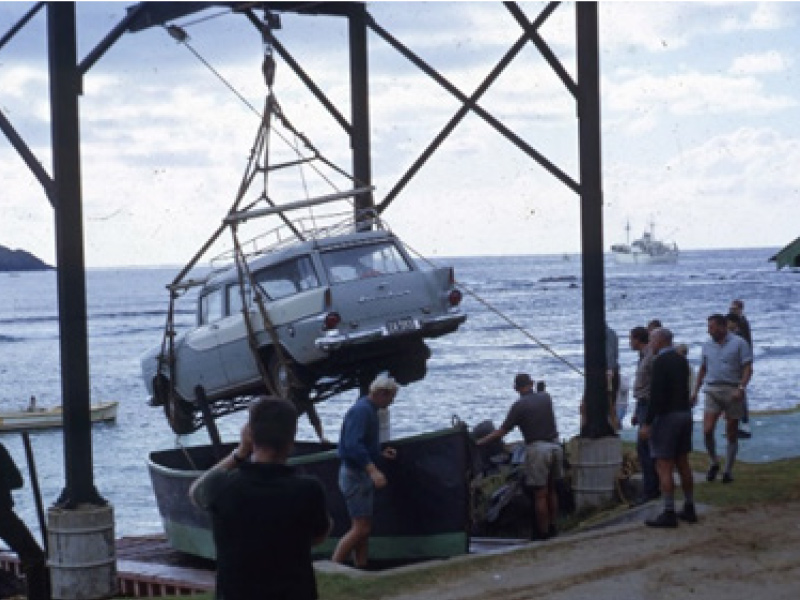By Clive Wilson19th September 2024
The following is a brief summary of Burns Philp’s involvement with Lord Howe Island.
Their first ships involved in servicing Lord Howe were SS Ysobel, SS Tambo and SS Ovalau.

SS Mokambo’s first contact with Lord Howe was in 1911, and she serviced the Island until 1931, when she was replaced by the passenger cargo vessel, “Morinda”.
The “Morinda” was really the Island’s lifeline and support service for the tourist industry until the Second World War began, affecting the Island from 1940 on.
During World War II, the “Morinda’s” calls became less frequent because of requests for her to support the allied forces defending the Solomon Islands, Vanuatu and potentially Norfolk Island and Lord Howe Island. We were all aware of the close presence of Japanese forces and naval units, particularly when the French passenger cargo vessel “Polynesie” was sunk by a Japanese submarine, approximately 90 nautical miles northwest of Lord Howe Island, on a voyage to Noumea.
In 1925, Burns Philp had submitted a request to Island authorities to build a small store on the Island to support their operations. This request was refused and relations between Burns Philp and the Island community were somewhat strained for some time after this.
However, Burns Philp continued their services to this community using the “Morinda” until the first week of December, 1951.
The “Morinda” was then docked for extensive attention to machinery and the hull and the 700 tonne BP Inter-Island Vessel, “Muliama”, made several calls with urgent supplies for Lord Howe and Norfolk. The delay in repairing the “Morinda” was longer than expected and, when supplies ran critically short, Burns Philp arranged via the Government, for the SS Bungaree to make urgent calls to Lord Howe Island and Norfolk Island during December, 1946, and January, 1947.
The “Morinda” made her final voyage to Lord Howe, Norfolk and Vanuatu in November and December, 1951, and was replaced by the “Malaita” in April, 1952, with interim voyages for supply reasons by “Muliama” and “Wanyui” from February, and by the “Awahou” in early April.
The “Malaita” made her first regular voyage to Lord Howe Island in late April, 1952.
The real nail in the coffin for Burns Philp was the slow turnaround time for their vessels, particularly at Neds Beach during winter months. In May, 1953, “Malaita” grounded on a rock off Neds Beach causing some substantial damage to the hull and the ship was delayed at Lord Howe for about a week while appropriate repairs were being made. Following the incident, the Company announced that they would withdraw their services from Lord Howe in late 1953.

This caused a great deal of consternation on the Island, but Burns Philp felt that the slowness of the turnarounds at Lord Howe was interrupting their other services in the South Pacific.
The real cause of the problem was the operations of the Flying Boat Services on the Lagoon interfering with the number of men available to handle the cargoes at Neds Beach and the work really was becoming slower and slower.
No end was in sight to improving the turnaround time and so the next group to become involved with cargo to Lord Howe was Captain Savoie with the various “Jacques Del Mar”s.
Burns Philp certainly did not leave Lord Howe in the lurch and during the flying boat years made a number of calls to the Island to allow flying boats to be repaired and re-engined when Captain Savoie was indisposed.
After much controversy and discussion, the problem of cargo handling at Neds Beach was solved with the erection of a slipway and a heavy cradle to suit. Heavy cargo handling improved on that site from 40 – 50 tonnes per day to totals of 80 – 150 tonnes per day depending on sea conditions and finally, on a good day, reaching as much as 180 tonnes.
The improvement was also the result of having three heavy trucks and two trailers available for moving cargo off site. Finally, when reticulated power became available on the Island, the handling of drummed fuel for the powerhouse, and other cargo, was much more easily handled at Neds with the new facility.
When the mobile crane arrived on the Island in the early 1970’s, there was a great deal of improvement to cargo handling on both sides of the Island.



